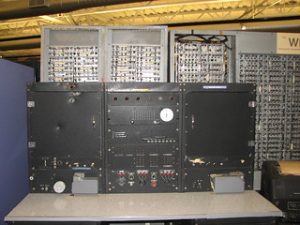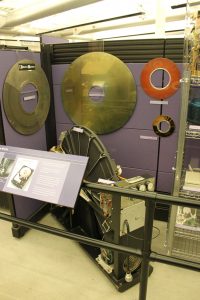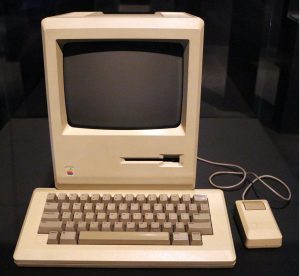Digital Information Environment
53 History of Computers
Chandler Little; Ben Greene; and Samuel Blankenship
Introduction
Modern technology first started evolving when electricity started to be used more often in everyday life. One of the biggest inventions in the 20th century was the computer, and it has gone through many changes and improvements since its creation. The last two decades have shown more advancement in technology than any other invention. They have advanced almost every level of learning in our lives and looks like it will only keep impacting through the decades. Computers in today’s society have become a focal point for everyday life and will continue to do so for the foreseeable future. One important company that has shaped the computer industry is Apple, Inc., which was founded in the final quarter of the 20th century. This is one of the primary computer providers in American society, so a history of the company is included in this chapter to contribute specific information about a business that has propelled the growth of computer popularity.
For this chapter we will define computers as “A machine that executes a sequence of instructions according to some preset arithmetic.” This means that a machine is an device built to perform tasks in a set order that has been designed prior, like a recipe. For example, when typing on a laptop it is going through a set of commands that correlate the pressing of a key to some action that then displays the letter pressed onto the screen in a way that can be understood by people.
The Evolution of Computers
Computers have come a long way from their creation. This first computer was created in 1822 by Charles Babbage and was created with a series of vacuum tubes, ultimately weighing 700 pounds- far larger than computers today. Computers have vastly decreased in size due to the invention of the transistor in 1947, which revolutionized computing by replacing bulky vacuum tubes with

smaller components that made computers more compact and also more reliable. This led to an era of rapid technological advancement, leading to the development of integrated circuits, microprocessors, and eventually the smaller, lighter personal computers that have become indispensable in modern society. For example, most laptops today weigh in the range of two to eight pounds. A picture of one of the first computers can be seen in Figure 1. There have been large amounts of movement in the data storage sector in computers. The very first hard drive was created in 1956 and had a capacity of 5MB and weighed in at 550 pounds.
Today hard drives are becoming smaller and we see them weighing a couple of ounces to a couple of pounds. As files have come more complex, the need for more space in computers has increased drastically. Today we see games take up to 100GB of storage. To give a reference as to how big of a difference

5MB is to 100GB of storage is that 5MB is .005 GB. The hard drives we have today are seeing sizes from 10TB and larger. A TB is 1000GB. The evolution of the hard drive can be seen in figure 2. As the world of computers keeps progressing, there is a general concept of making them smaller, but at the same time seeing a generational step in improvement. The improvements allow the daily tasks of many users (like teachers, researchers, and doctors) to become shorter, making their tasks quicker and easier to accomplish. New software is also constantly being developed, and as a result, we are seeing strides in staying connected to others in the ways of social media, messaging platforms, and other means of communication. The downside to this growing dependence on computers is that technological failures/damages can create major setbacks on any given day.
relation to sts
The development of computers as a prevalent form of technology has had a profound impact on society as a whole in the United States. Computers are now ubiquitous, playing a crucial role in various aspects of everyday life. They are utilized in most classrooms across the country, facilitating learning and enhancing educational experiences for students of all ages. In the workplace, computers have revolutionized business operations, streamlining processes, increasing efficiency, and enabling remote work capabilities. Additionally, computers have become indispensable tools in households across America. According to the U.S. Census Bureau’s American Community Survey, a staggering 92% of households reported having at least one type of computer (2021). This statistic underscores the widespread integration of computers into the fabric of American life. The impact of computers extends beyond mere accessibility. They have transformed communication, allowing people to connect instantaneously through email, social media, and video conferencing platforms. Additionally, computers have revolutionized entertainment, providing access to a vast array of digital content, from streaming services to video games.
Overall, the pervasive presence of computers underscores their monumental impact on Americans’ lives, shaping how we learn, work, communicate, and entertain ourselves. Computers have already shown to be one of the largest impacts on society, science, and technology that the world has ever known. Computers are seen daily by most people, whether it be their phones, televisions, laptops, smartwatches etc. Science is not unaffected with research papers and studies utilizing the technological advancements of computers to streamline scientific discoveries. Computers are more and more prevalent in day to day life for all people and therefore will continue to impact and shape the way science, technology, and society grows and changes.
missing Voices in computer history

The evolution of computers has been happening at a fast rate, and when this happens people’s contributions are left out. The main demographic in computers that are left out are women. Grace Hopper is one of the most influential people in the computer spectrum, but her work is not shown in the classroom. In the 1950s, Grace Hopper was a senior mathematician on her team for UNIVAC (UNIVersal Automatic Computing INC). Here she created the very first compiler (Cassel, 2016). This was a massive accomplishment for anyone in the field of computing because it allowed the idea that programming languages are not tied to a specific computer, but can be used on any computer. This single feature in computers was one of the main driving forces for computing to become so robust and powerful that it is today. Grace Hopper’s work needs to be talked about in classrooms not only just in engineering courses, but as well as general classes. Students need to hear that a woman was the driving force behind the evolution of computing. By talking about this, it may urge more women to join the computing field because right now only 25% of jobs in the computing sector are held by women (Cassel, 2016). With a more diverse workforce in computing, we can see the creation of new ideas and features that were never thought of before.
During the evolution of computers, many people have been left out with their creation with respect to the development and algorithms. With the push to gender equality in the world in future years, this gap between the disparity between women’s credibility and men’s credibility will be shrunk to a negligible amount. As computers continue to evolve the world of STS will need to evolve with them to adapt to the changes in technology. If not, some of the great creations in the computer sector will be neglected, and most notoriously here is VR (Virtual Reality) with its higher entry-level price and motion sickness that comes along with VR (Virtual Reality).
history of apple, inc.
In American society today, two primary operating systems dominate: Windows and MacOS. MacOS is the operating system for Apple computers, which were estimated to cover about 16.1% of the U.S. personal computer market in the fourth quarter of 2023 according to a study from Gartner (2024). The company Apple Inc. was founded on April 1, 1976, by Steve Jobs and Steve Wozniak who wanted to make computers more user-friendly and accessible to individuals. Their vision was to revolutionize the computer industry. They started by building the Apple I in Jobs’ garage, leading to the introduction of the Apple II, which featured color graphics and propelled the company’s growth. However, internal conflicts and the departure of key figures like Jobs and Wozniak led to a period of struggle in the 1980s and early 1990s. Jobs returned to Apple in 1997 and initiated transformative changes, including an alliance with Microsoft and the launch of groundbreaking products like the iBook and iPod. Apple continued to expand their product line, with the introduction of the iPhone in 2007 marking a new era of success for Apple, propelling it to become the second most valuable company in the world. Apple has been able to maintain a strong position in the technology market for this entire period by continuously improving its beginning product, the Macintosh computer, and by adapting to new technological changes.

Apple’s Macintosh computers have changed quite a lot throughout the company’s history. The Macintosh 128k (figure 3) was the very first Apple computer, released on January 24, 1984. It had a 9-inch black and white display with 128KB of RAM (computer memory) and operated on MacOS 1.0. The next important release was in April 1995 with several variations of the Macintosh Performa which had 500MB to 1 GB of memory. Interestingly, the multiple models of this computer ended up competing with each other and were discontinued. This led to the iMac G3 in August 1998 which sported a futuristic design with multiple color options for the back of the computer as well as USB ports, 4GB of memory, and built-in speakers. iMac G3 was the beginning of MacOS 8. In 2007, the iMac went through a major redesign with melded glass and aluminum as the material and a widescreen display. The newer Mac’s continue to be built slimmer, with faster processors, better displays, and more storage (Mingis and Moreau, 2021).
Missing voices within apple
In a male-dominant field, it’s very possible for women’s impacts to be drowned out in technological evolutions. Within Apple’s business specifically, several women have made a large difference in their progression. Susan Kare for example, was the first designer of Apple’s icons like the stopwatch and paintbrush that helped Apple establish the Mac. Another woman

with a large contribution to Apple was Joanne Hoffman. She was the fifth person to join Macintosh in 1980 and “wrote the first draft of the User Interface Guidelines for the Mac and figured out how to pitch the computer at the education markets” in the beginning of Apple’s existence (Evans, 2016).
Conclusion
Throughout this chapter, the importance of computers as a catalyst for advancement in our society is evident. Clearly computers have evolved from their inception up until this point today in multiple different ways, and several people from several different backgrounds have played an important part in this. Computers as they have evolved have grown to meet the needs of the society at that time, however, computers are still machines that execute a preset, set of instructions for the user.
How has the advancement in technology improved your life?
REFERENCES
A brief history of computers – unipi.it. (n.d.). Retrieved November 7, 2022, from https://digitaltools.labcd.unipi.it/wp-content/uploads/2021/05/A-brief-history-of-computers.pdf
Cassel, L. (December 15, 2016 ). “Op-Ed: 25 Years After Computing Pioneer Grace Hopper’ s Death, We Still Have Work to Do”. USNEWS.com, Thursday. Accessed via Nexis Uni database from Clemson University.
Computers: Timeline of Computer History: Computer History Museum. Computers | Timeline of Computer History | Computer History Museum. (n.d.). https://www.computerhistory.org/timeline/computers/
Evans, J. (2016, March 8). 10 Women Who Made Apple Great. Computerworld. https://www.computerworld.com/article/3041874/10-women-who-made-apple-great.html
Gartner. (2024, January 10). Gartner Says Worldwide PC Shipments Increased 0.3% in Fourth Quarter of 2023 but Declined 14.8% for the Year. Gartner. https://www.gartner.com/en/newsroom/press-releases/01-10-2024-gartner-says-worldwide-pc-shipments-increased-zero-point-three-percent-in-fourth-quarter-of-2023-but-declined-fourteen-point-eight-percent-for-the-year#:~:text=HP%20maintained%20the%20top%20spot,share%20(see%20Table%202).&text=HP%20Inc.,-4%2C665
Kleiman, K. & Saklayen, N. (2018, April 19). These 6 pioneering women helped create modern computers. ideas.ted.com. Retrieved September 26, 2021, from https://ideas.ted.com/how-i-discovered-six-pioneering-women-who-helped-create-modern-computers-and-why-we-should-never-forget-them /.
Mingis, K. and Moreau, S. (2021, April 28). The Evolution of the Macintosh – and the Imac. Computerworld. https://www.computerworld.com/article/1617841/evolution-of-macintosh-and-imac.html
Pottenger, W.M., Hemmendinger, D., Freiberger, P.A., Swaine, M.R. (2024, December 20). computer. Encyclopedia Britannica. https://www.britannica.com/technology/computer
Richardson, A. (2023, April). The Founding of Apple Computer, Inc. Library of Congress. https://guides.loc.gov/this-month-in-business-history/april/apple-computer-founded
Tanenbaum, A. S., & Austin, T. (2013). Structured Computer Organization. Pearson.
Thompson, C. (2019, June 1). The gendered history of human computers. Smithsonian.com. Retrieved September 26, 2021, from https://www.smithsonianmag.com/science-nature/history-human-computers-180972202/.
Women in Computing and Women in Engineering honored for promoting girls in STEM. (May 26, 2017 Friday). US Official News. Accessed via Nexis Uni database from Clemson University.
Zimmermann, K. A. (2017, September 7). History of computers: A brief timeline. LiveScience. Retrieved September 26, 2021, from https://www.livescience.com/20718-computer-history.html.
IMAGES
“Gene Amdahl’s first computer.” by Erik Pitti is licensed under CC BY 2.0
Hoffman, J. (Photographer). (n.d.). [Title of the image, if known] [Photograph]. AppleInsider. https://photos5.appleinsider.com/gallery/36183-67076-000-lead-Joanna-Hoffman-xl.jpg
“First hard drives” by gabrielsaldana is licensed under CC BY 2.0
Sailko. (2017). Neo Preistoria Exhibition (Milan 2016). Wikipedia. https://en.wikipedia.org/wiki/Macintosh_128K#/media/File:Computer_macintosh_128k,_1984_(all_about_Apple_onlus).jpg
The National WWII Museum. Admiral Grace Murray Hopper: When Women Were Computers. The National WWII Museum, 25 Mar. 2022, www.nationalww2museum.org/war/articles/grace-hopper-woman-computer.
AI ACKNOWLEDGMENT
I acknowledge the use of ChatGPT to generate additional content for this chapter.
Prompts and uses:
I entered the following prompt: Summarize the history of Apple in 7 sentences based on that prompt [the Library of Congress article].
Use: I modified the output to add more information from the article that I found relevant. I also adjusted the wording to make it fit the style of the rest of the chapter.
I entered the following prompt: The development of computers as a new, prevalent form of technology has majorly impacted society as a whole in the United States, as they are involved in several aspects of everyday life. Computers are used in some form in most classrooms in the country, in most workplaces, and in most households. Specifically, 92% of households in the U.S. Census Bureau’s American Community Survey reported having at least one type of computer. This is a simple statistic that shows the monumental impact of computers in Americans’ lives.
Use: I used the output the expand upon this paragraph; after entering the prompt, ChatGPT added several sentences and reworded some of the previously written content. I then removed some of the added information from ChatGPT and made the output more concise.
I entered the following prompt: Give me 3 more sentences to add to the following prompt. I am trying to talk about the history of computers and how they were invented. The prompt begins now- Computers have come a long way from their creation. This first computer was created in 1822 by Charles Babbage. This computer was created with a series of vacuum tubes and weighed a total of 700 pounds, which is much larger than the computers we see today. For example, most laptops weigh in a range of two to eight pounds.
After getting this output, I wrote this prompt: Give me two more sentences to add to that.
Use: I used the 5 sentences of the output to select the information that I wanted and add it to the content that was already in the book in order to provide more detail to the reduction in sizes of computers over time.

